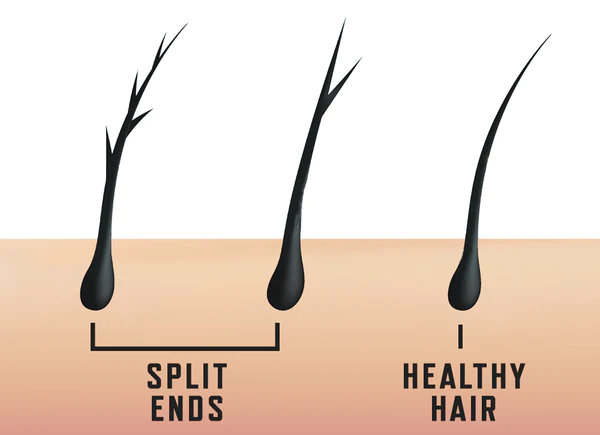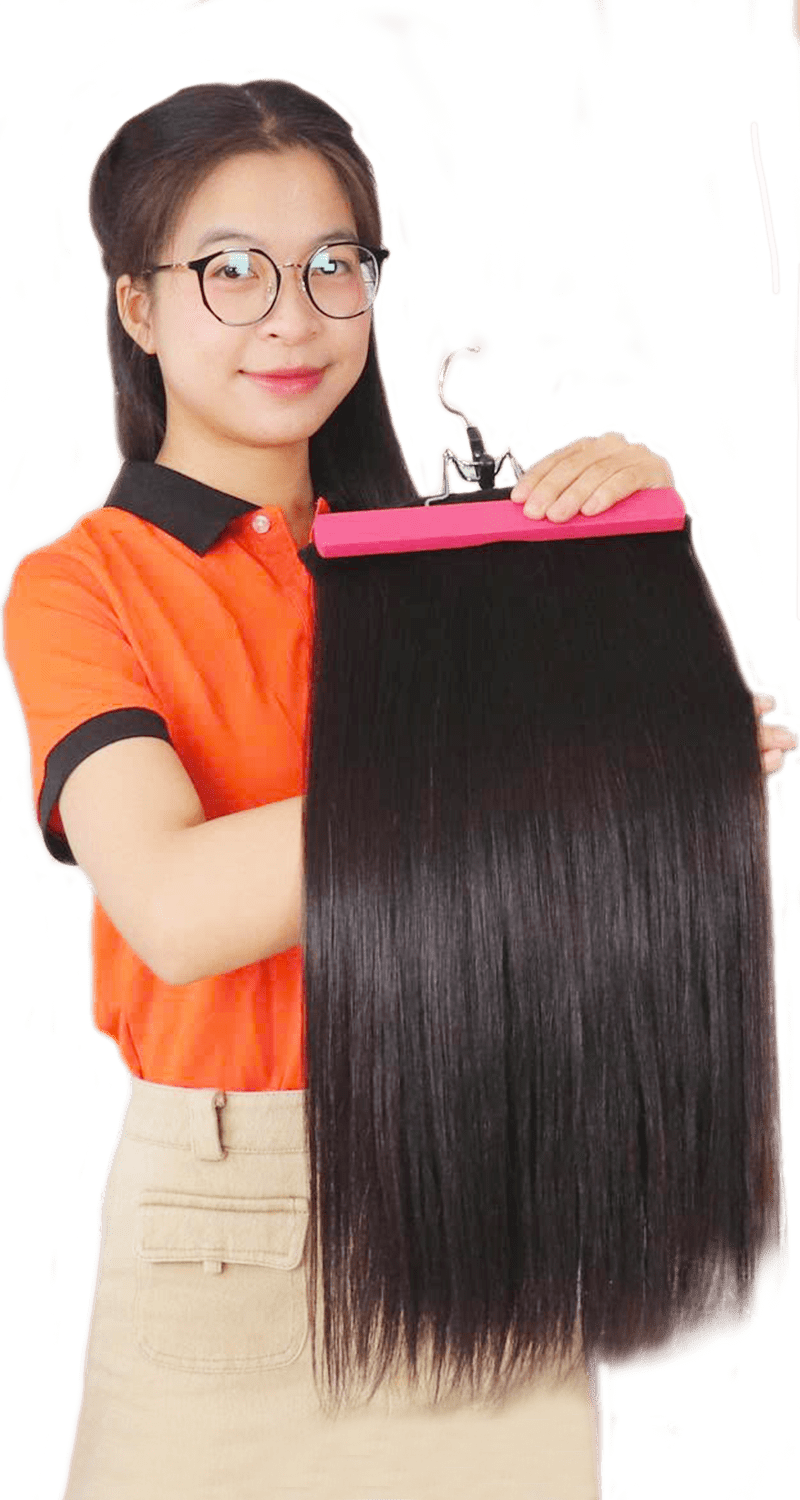Welcome to another installment of natural hair advice! Today we’ll talk about a problem that everyone with hair on their head has: split ends. Let’s face it: we all have split ends, regardless of our hair texture. And, as much as we’d like to believe that split ends can be magically repaired, the chances are slim to none. However, we understand that maintaining healthy, strong hair can be difficult, especially if you don’t know where to start. So we asked hair experts to tell us everything we needed to know about split ends, from what causes them to how to get rid of them without having to endure a drastic haircut.
I. What Are Split Ends?
Daily wear and tear on your hair will degrade and wear down the cuticle over time, exposing the inner cortex. Split ends are the result of a single strand of hair-splitting into two. They are caused by the hair shaft splitting or fraying. The end is the most exposed and vulnerable part of your hair so split ends are most noticeable at the ends of your hair, but they can occur anywhere on the hair strand.

Don’t worry, they are completely normal; however, in large quantities, they are a major concern. Split ends are not only unsightly, but they can also indicate that your hair is damaged, dry, or otherwise unhealthy. If you fail to properly care for your hair, this problem will only worsen, resulting in severe hair breakage throughout your hair strands and brittleness.
II. What Causes Split Ends?
While split ends can develop rapidly due to extreme damage, they usually develop slowly as the result of small damaging factors. The following are some of the most common processes that damage and degrade the end of your hair cuticle:

- Bad Hair Habits: Common culprits are everyday stresses to your hair like taking extremely hot showers, brushing your hair roughly, putting your hair up in a towel to dry, and even sleeping with your hair tied back in a bun or ponytail, these are all factors that break down the cuticle little by little, causing split or make them worse.
- Heat: Heat tools are one of the fastest ways to cause split ends or worsen your condition of split ends. Heated tools strip moisture from the hair which is what makes your hair delicate and far more susceptible. Using the wrong sorts of hair products that are full of drying agents and alcohols that will strip your hair of moisture will only increase dryness and hair breakage overall throughout your hair.
- Friction: Some fabrics and materials cause more damage to your cuticle than others. Hats, scarves, and sweaters accelerate the development of split, as do cotton pillowcases and towels.
- Environment: Wind, cold, heat, sun, dry climates, humid climates … it seems like no matter what the weather, it takes a toll on your hair. Environmental aggressors such as too much sun exposure or a lack of humidity can lead your hair down a path to dryness which in turn creates split.
- Internal factors: Your diet, the water your drink, and the overall health of your body impact the strength of your hair. If your body is dehydrated, malnourished, or protein-deficient, your hair will be too, and thus more susceptible to split.
III. What Your Kind of Split Ends Say About You
We’re shedding light on “What Your Kind of Split Ends Say About You” with the 6 most common types:

1. The Basic Split Ends (Split)
Also known as traditional split, basic split ends are the most common type of split. These are caused when the cortical cells of the hair begin to separate from each other, although they are still largely held together. Basic split ends form due to dehydration, dryness, strain, and friction.
What they say about you: You need to nourish and hydrate your hair more often, but it’s not too late!
- Use a treatment that helps seal and heal your ends like Living Proof’s Perfect hair Day Fresh Cut Split End Mender.
- Oiling your hair once a week with coconut or olive oil can help you get rid of these basic splits.
- Use a deep conditioner once every two weeks to provide intense moisture to your tresses.
- Replenish your diet with nuts rich in zinc, like pecans and walnuts, to avoid traditional split ends.
- You can also use honey-based DIY hair masks every week or every two weeks to hydrate your tresses naturally.
2. Baby (Mini) Split Ends
Baby splits are smaller in proportion to regular split ends and indicate early split-end development. If you catch a split end while it is still small, you need to treat it before it worsens.
What they say about you: Baby splits are a sign that your hair is dehydrated. Luckily, it can still be repaired if the necessary treatment is given on time. Use moisturizing hair masks and deep condition your hair to hydrate it. You also need to heal and seal those ends by trimming your hair.
3. Triple (The Triangle Or Fork Split)
In this type of split, the hair end is divided into three strands, resembling a fork. Triangle or fork splits are a sign of widespread damage to the hair fiber.
What they say about you: Your hair could use more deep conditioning mask treatments, as well as trimming your hair regularly.
4. The Tree Split
In the tree split, several branches emerge from a single split end and the cortical cells begin to separate. This means one side of the hair shaft has been damaged more than the other. Sunburn and excessive weathering may be some of the reasons behind tree split ends.
What they say about you: You need to book a haircut appointment ASAP. If not nourished properly, your hair can look intensely frizzy. Also, use a wide-toothed comb that does not snag at the split ends.
5. The Candle Split
The candle split is slightly different from the other types of splits in that it has not yet been converted into a split, but it can any time soon. Your hair looks much thinner at the ends, and the damage on the outer cuticle is pretty evident.
What they say about you: You need a trim (duh!), but in the meantime use a split end treatment or nourishing essential oil to do some pre-damage control.
6. The Single-Strand Knot
The single-strand knot normally occurs in curly hair when a curl is tangled and causes a knot in a single strand, initiating multiple tangles. This leads to breakage while brushing your hair.
What they say about you: If you have curly hair, you need to be extra careful when you brush it so as not to cause breakage.
IV. How To Prevent Split Ends
It’s difficult to prevent split ends. Still, there are things you can do to reduce their frequency and severity.

- Get regular haircuts and trims, preferably every 6 weeks.
- Don’t wash your hair daily. When you do wash, consider only using conditioner and skipping a shampoo.
- Choose all-natural shampoos that contain no harsh ingredients.
- Use a conditioner after shampooing or use a leave-in conditioner.
- Use a wide tooth comb to detangle wet hair.
- Limit services that damage hair, such as coloring and chemical straightening.
- Use a heat-protective spray, and minimize the use of heat.
- Take supplements that strengthen the hair, such as biotin and folic acid.
- Some hairstyles, like ponytails and hair twists, can cause split ends. Limiting how often you wear these hairstyles and using softer hair ties may help prevent damage.


 BEST SELLING PRODUCTS
BEST SELLING PRODUCTS Wig Hair
Wig Hair WHOLESALE
WHOLESALE Contact us
Contact us Sale Events
Sale Events
